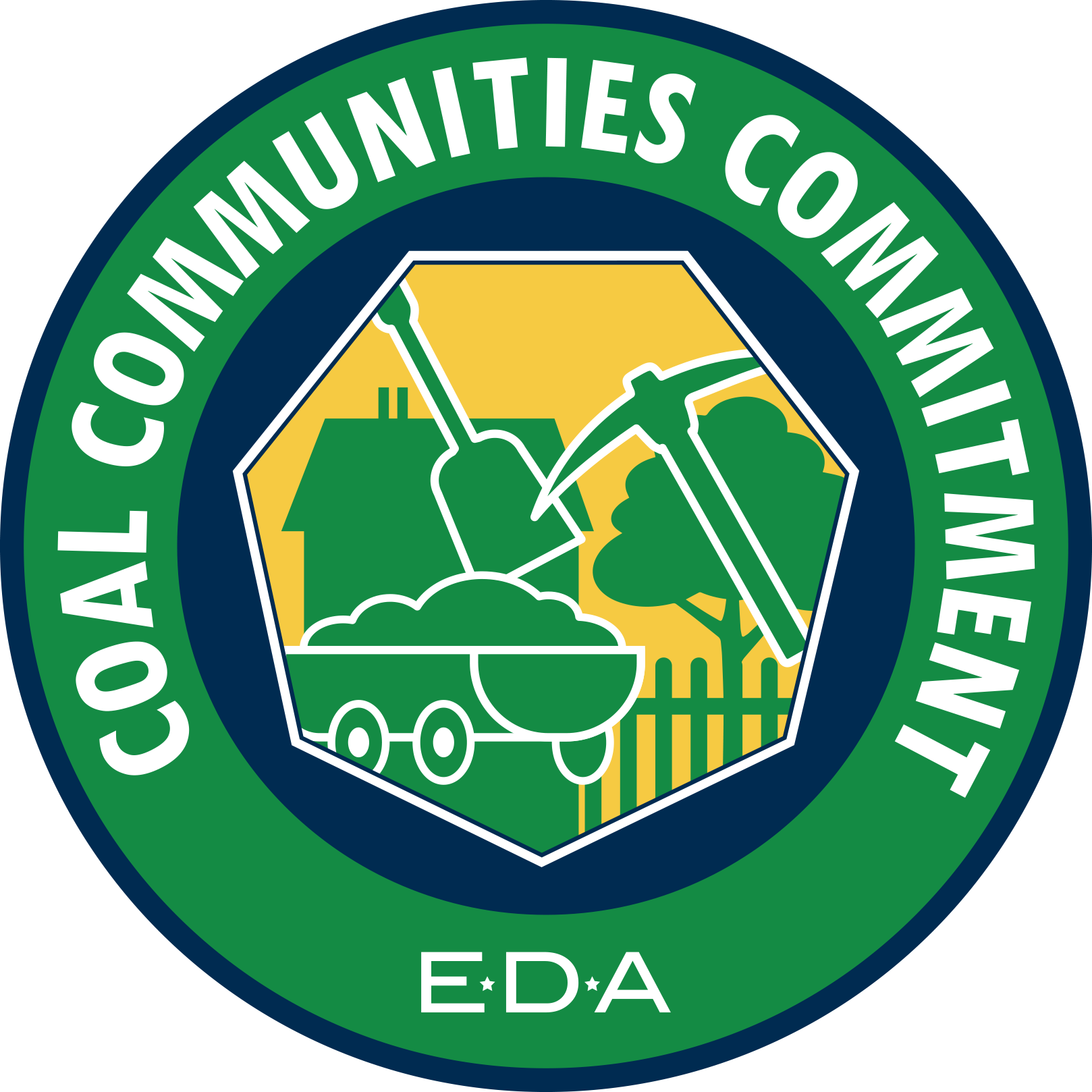American Rescue Plan Coal Communities Commitment – Frequently Asked Questions
August 2, 2021
Contents

- How does EDA define a coal community?
- How much funding has EDA pledged to support coal communities?
- For which American Rescue Plan programs are coal communities eligible?
- Who is eligible for grants that support coal communities?
- What types of projects are eligible that support coal communities?
- How can I submit my application for EDA funding?
- What is the deadline to submit my application?
- Are coal communities eligible for EDA funding outside of the American Rescue Plan programs?
- What should I do if I have additional questions not answered in this FAQ?
1. How does EDA define a coal community?
Coal communities are communities and regions that can reasonably demonstrate how changes in the coal economy have resulted or are anticipated to result in job losses and layoffs in any coal-reliant commercial sector. This includes, but is not limited to:
- Coal mining
- Coal-fired power plants
- Related transportation, logistics, and/or supply chain manufacturing industries
In general, EDA will consider applications for projects in communities and regions where the primary coal economy contraction “event” (e.g., closure of a coal mine or a coal-fired power plant, closure of various coal economy supply chain businesses, etc.) took place within 15 years prior to the application submission date. Note, this timeframe is a range during which projects will generally be eligible; applicants may propose projects outside this timeframe, but should take special care to demonstrate that the primary coal economy contraction “event” continues to tangibly impact the community.
There is no pre-defined list of impacted coal communities. To demonstrate eligibility, complete applications must provide appropriate third party economic and demographic statistics that document the extent to which contractions in the coal economy have negatively impacted the community or region.
2. How has EDA pledged to support coal communities?
The pandemic, paired with the downturn in the coal industry, has made it challenging for workers in coal communities to find the good-paying union jobs they need. In April, EDA updated its Investment Priorities which lay out the basis of how EDA evaluates all competitive grant applications across all of their Notices of Funding Opportunity (NOFOs). The “Recovery and Resilience” priority was designed to support these American workers by elevating “projects that build economic resilience to and long-term recovery from economic shocks, like those experienced by coal and power plant communities.”
As a part of EDA’s $3 billion American Rescue Plan funding, EDA is making a Coal Communities Commitment, allocating $300 million to ensure support for these communities as they recover from the pandemic and create new jobs and opportunities, including through the creation or expansion of a new industry sector. This commitment will be fulfilled by allocating $100 million in Build Back Better Regional Challenge grants to coal communities and $200 million in Economic Adjustment Assistance grants to coal communities.
Additionally, EDA is providing planning and technical assistance grants to help support states in their effort to develop plans to revitalize coal communities and offer opportunities to develop national communities of practice to support coal communities in executing their vision to build resilient economies. Further information on these programs can be found in the Statewide Planning, Research, and Networks Notice of Funding Opportunity.
3. For which American Rescue Plan programs are coal communities eligible?
Coal communities are eligible to receive funding from all of EDA’s American Rescue Plan programs. Specifically, EDA will fulfill its Coal Communities Commitment through the Build Back Better Regional Challenge grants and the Economic Adjustment Assistance grants.
Please visit https://eda.gov/arpa/coal-communities/ for additional details.
4. Who is eligible for grants that support coal communities?
Eligible applicants for EDA’s American Rescue Plan funding are set out in each Notice of Funding Opportunity. These applicants may include:
- District Organizations of EDA-designated Economic Development Districts (EDDs)
- Indian Tribes, which includes Federally-recognized Indian Tribes and any Alaska Native Village or Regional Corporation (as defined in or established under the Alaska Native Claims Settlement Act (43 U.S.C. 1601 et seq.)1
- State and Local governments or political subdivisions, including special purpose units of State or local government engaged in economic or infrastructure development activities, which may include regional water and sewer districts, airport commissions, and regional economic development commissions
- Institutions of higher education
- Public or private nonprofit organizations or associations working in cooperation with officials of a general purpose political subdivision of a State (e.g., a city, town, or county)
Funding allocated for EDA’s Coal Community Commitment is only available for coal communities, as defined in question 1 above.
5. What types of projects are eligible that support coal communities?
Coal communities can apply for investment assistance on a wide range of technical, planning, workforce development, entrepreneurship, and public works and infrastructure projects.
You can find more specific information on eligible projects under the Build Back Better Regional Challenge and the Economic Adjustment Assistance Notices of Funding Opportunity, visit their respective FAQ pages linked here.
Please visit https://eda.gov/funding-opportunities/ for details on all of EDA’s programs and each’s project eligibility requirements.
6. How can I submit my application for EDA funding?
All EDA NOFOs and application forms are posted at www.grants.gov, and can be accessed either by searching www.grants.gov for the funding opportunity you would like, or accessing the link directly through https://eda.gov/funding-opportunities/.
Before applying for EDA funding, an organization must take several steps to obtain credentials and register with several systems that may require 25 or more business days to complete. The technical requirements and systems associated with generating these credentials require confirmation at each step and the process can be lengthy—especially for organizations without an employer identification number (EIN) —and require interaction with multiple organizations outside of EDA.
EDA strongly encourages applicants in the process of forming or that have formed but are not yet registered on www.grants.gov, to do so as soon as possible.
7. What is the deadline to submit my application?
Application deadlines are specific to each Notice of Funding Opportunity. Please visit https://eda.gov/funding-opportunities/ for details on each program’s deadline.
EDA strongly encourages applicants to submit applications early and not wait until the application deadline.
8. Are coal communities eligible for EDA funding outside of the American Rescue Plan programs?
Yes, coal communities are eligible to benefit from all of EDA’s programs, depending on the applicant and type of project.
Specifically, EDA’s Assistance to Coal Communities (ACC) program is available through EDA’s Public Works and Economic Adjustment Assistance Notice of Funding Opportunity. Through ACC, EDA awards funds on a competitive basis to assist communities severely impacted by the declining use of coal through activities and programs that support economic diversification, job creation, capital investment, workforce development, and re-employment opportunities.
For details on all of EDA’s Notices of Funding Opportunity, please visit: https://eda.gov/funding-opportunities/
9. What should I do if I have additional questions not answered in this FAQ?
- Connect with your state’s Economic Development Representative regarding the Economic Adjustment Assistance program. Contact information can be found at: https://eda.gov/contact/
- Send your questions for the Build Back Better Regional Challenge to this inbox: [email protected]
- Find your Economic Development District for planning support and technical assistance: https://eda.gov/resources/directory/
1. Please note that this includes the governing body of a Tribe, non-profit Indian corporation (restricted to Indians), Indian authority, or other non-profit Indian Tribal organization or entity; provided that the Indian Tribal organization or entity is wholly owned by, and established for the benefit of, the Indian Tribe or Alaska Native Village.





